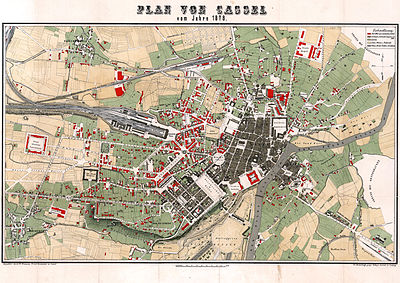Emil way
Julius Emil Weise (born March 13, 1832 in Lauban ; † April 13, 1899 in Dresden ) was a German lawyer , Prussian administrative officer and Lord Mayor of Naumburg and Kassel .
Life
Julius Emil Weise grew up in Lauban (today: Lubán) in the then Prussian province of Silesia . After studying law and doing his doctorate , he became a court assessor in 1860 and a year later mayor of the town of Jauer (today Jawor), about 80 km east of his hometown . In 1864 he became the first salaried city councilor in Naumburg an der Saale , there in 1866 an alderman , in 1867 mayor and finally on March 3, 1867 mayor .
On July 11, 1873, he was elected deputy to the Lord Mayor of Kassel, Friedrich Nebelthau , in the great hall of the city building on the Fuldabrücke by the election committee consisting of members of the Kassel city council, the ordinary and the extraordinary citizens' committee . Nebelthau died two years later. Weise became mayor himself on December 4, 1875 and moved with his family into the mayor's official apartment in the town hall on Obere Karlsstrasse . Like his predecessor, Weise was a member of the National Liberal Party (NLP). In 1887 he was re-elected for eight years by a large majority and in 1891 was appointed a secret councilor.
During Weise's 19-year tenure at the head of the city administration, the old residential and civil service town developed into an up-and-coming industrial metropolis, whose population grew from around 50,000 in 1873 to around 75,000 in 1892. With around 1,600 employees, the Henschel & Sohn machine factory was the largest company and produced over 3,000 locomotives at its location northeast of the city center by 1890. In 1882 the Wegmann & Co. wagon factory was founded in Rothenditmold. The textile industry , which entrepreneurs such as Sigmund Aschrott , Heinrich Salzmann and Moritz Gottschalk developed from working at home to manufacturing in factories, also became important. Many other branches of industry and trade establishments were added.
Kassel's new function as the capital of the Prussian province of Hessen-Nassau , founded in 1868 , seat of the district government and the general command of the XI. Army corps promoted urban development. With the French reparations payments after the Franco-Prussian War for the 83rd Infantry Regiment, which had previously been stationed in the city center, a considerably enlarged facility was built on Kölnische Strasse in the west, opened up by what later became Hohenzollernstrasse, and this initiated the development of the Vorderen West . In 1878 the Train depot and the Train barracks between Ihringshäuser Allee and Möncheberger Straße were completed.
In the city center, the picture gallery , designed by Weise's predecessors, was inaugurated in 1877 . From 1878 a new government building was built in place of the ruins of the old Chattenburg . In 1881 an imperial main post office was built on Königsplatz .
The development of new residential areas for the growing population posed a particular challenge. As early as the 1860s, Siegmund Aschrott had started to buy up areas in the western part of the city and in the districts of Wehlheiden , Kirchditmold and Wahlershausen in order to develop them on their own account and then to build on them or to sell undeveloped, profitably. While the city initially gave him a free hand in the sense of a laissez-faire , especially since the responsibilities between the city and the police department were still unclear, Weise increasingly succeeded in bringing public interests into the planning and implementation through urban development contracts and the quality of the to increase urban planning . On the basis of the Prussian flight line law , which was renewed in 1875 , the city council decided and published a statute for the further development of the Front West in 1884 .
Weise was seen as the "honest trustee of Kassel concerns". His “noble, humane sense” was also evident in his resolute rejection of the anti-Semite petition of the Berlin movement , which was also discussed in Kassel in 1880.
In 1891, Weise received an orphanage foundation from the entrepreneur George André Lenoir for the city of Kassel , which was later increased to 6.5 million marks . In September of that year he received Kaiser Wilhelm II in Kassel , who has since regularly used Wilhelmshöhe Palace as a summer residence.
At the end of 1892, Weise resigned from his post prematurely for health reasons. He first moved to Freiburg im Breisgau and later to Dresden, where he died in 1899.
Of all the city's mayors, he has had the longest term to date. "Goodness and humanity were his salient qualities," it said in an obituary. His wife Johanna survived him for 22 years.
literature
- Roland Demme: The Jewish businessman, publisher and city planner Sigmund Aschrott. A 19th century personality. Dissertation, University of Kassel, Kassel 2006.
- Dieter Pelda: The members of the Prussian Communal Parliament in Kassel 1867-1933. Elwert, Marburg 1999, ISBN 3-7708-1129-1 .
- City of Kassel (ed.), Vera Lasch (edit.): Kassel Lexikon. 2 volumes, euregioverlag, Kassel 2009, ISBN 978-3-933617-32-3 .
Web links
- Wise, Julius Emil. Hessian biography. In: Landesgeschichtliches Informationssystem Hessen (LAGIS).
Individual evidence
- ↑ Demme 2006, p. 200
- ↑ Demme 2006, p. 200
- ↑ Mayor information at kassel.de
- ↑ kassel.de
- ↑ Kasseler Tagblatt of December 12, 1880, quoted from Roland Demme: From the rectory to anti-Semitic politics. kassel university press, Kassel 2015, p. 121.
- ↑ kassel.de
| personal data | |
|---|---|
| SURNAME | Wise, Emil |
| ALTERNATIVE NAMES | Sage, Julius Emil (full name) |
| BRIEF DESCRIPTION | German lawyer, Prussian administrative officer and local politician |
| DATE OF BIRTH | March 13, 1832 |
| PLACE OF BIRTH | Lauban |
| DATE OF DEATH | April 13, 1899 |
| Place of death | Dresden |



